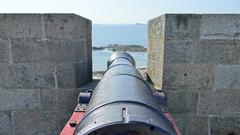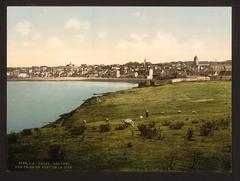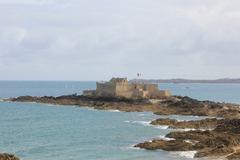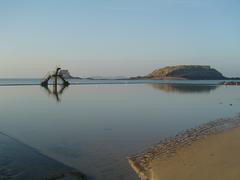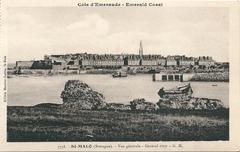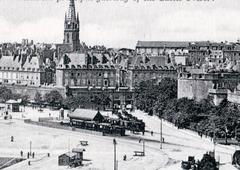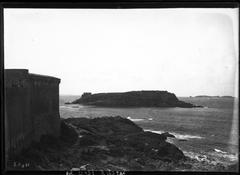
Comprehensive Guide to Visiting Saint-Malo, Ille-et-Vilaine, France
Date: 13/08/2024
Captivating Introduction
Welcome to Saint-Malo, a city that dances on the edge of the Atlantic, where each cobblestone street whispers tales of daring corsairs and resilient war heroes. Imagine stepping into a town where pirate legends come to life, where the scent of the ocean mingles with the whispers of history. Founded by the Welsh monk Saint Malo in the 6th century, this town’s strategic location on a granite promontory made it a natural fortress and a significant maritime hub (Journey to France). By the 12th century, Saint-Malo had evolved into a formidable fortress, becoming a haven for corsairs—privateers with official permission to attack enemy ships. The 17th and 18th centuries marked the golden age of privateering, with legendary figures like René Duguay-Trouin and Robert Surcouf capturing numerous enemy vessels, bringing immense wealth to Saint-Malo (Connexion France). However, the town’s history isn’t just about piracy. During the French Revolution and Napoleonic Wars, Saint-Malo was heavily fortified, although it faced economic hardships (France Voyage). The town’s resilience was tested again during World War II when Allied bombings in 1944 reduced approximately 80% of it to rubble. Yet, like a phoenix, Saint-Malo rose from the ashes, meticulously reconstructed to preserve its historical charm while incorporating modern amenities (France Voyage). Today, Saint-Malo is a vibrant blend of historical heritage and modern attractions, offering visitors a unique and memorable experience. Ready to uncover the secrets of this captivating city? Let’s dive in!
Table of Contents
- Historical Background
- Significance of Saint-Malo
- Historical Importance: The Birthplace of Legends
- World War II and Reconstruction: Rising from the Ashes
- Maritime Heritage: Sail the High Seas
- Cultural Significance: A Festival Wonderland
- Architectural Marvels: Walk Through Time
- Modern-Day Relevance: A Bustling Hub
- Economic Impact: Beyond Tourism
- Educational and Research Importance: Dive Deeper
- Environmental Significance: Nature’s Masterpiece
- Visitor Tips
Historical Background of Saint-Malo
Early Beginnings and Foundation
Saint-Malo, nestled in the Ille-et-Vilaine department of Brittany, France, traces its roots back to the 6th century. Named after the Welsh monk Saint Malo (or Maclou), who is said to have founded the commune, this town’s strategic location on a granite promontory made it a natural fortress and a significant maritime hub (Journey to France).
Medieval Era and Corsair Activity
By the 12th century, Saint-Malo had transformed into a formidable fortress with imposing granite walls. The town’s maritime prowess grew, becoming a haven for corsairs—privateers with official permission to attack enemy ships. Legendary figures like René Duguay-Trouin and Robert Surcouf amassed great wealth through their naval exploits (Connexion France).
The Golden Age of Privateering
The 17th and 18th centuries were the golden age of privateering. Corsairs like Duguay-Trouin captured numerous enemy vessels, bringing immense wealth to Saint-Malo. By age 18, Duguay-Trouin had captured five enemy ships in the English Channel (Connexion France). The riches from these ventures financed the construction of magnificent mansions called malouinières, which you can still visit today (Connexion France).
The Impact of the French Revolution and Napoleonic Wars
The French Revolution and subsequent Napoleonic Wars deeply affected Saint-Malo. With its strategic importance, the town was heavily fortified with numerous ramparts and offshore fortresses. Despite these defenses, Saint-Malo faced economic hardships and political upheaval during this period (France Voyage).
19th Century: Decline and Transformation
As naval warfare evolved and international treaties curtailed privateering, Saint-Malo adapted by transforming into a commercial port and a popular seaside resort. The town’s picturesque setting and historical significance attracted visitors, and it developed a reputation as a tourist destination (Journey to France).
World War II and Reconstruction
World War II brought significant destruction to Saint-Malo. In August 1944, Allied bombings aimed at driving out German troops almost completely destroyed the town, reducing approximately 80% of it to rubble (France Voyage). Post-war, a meticulous reconstruction effort restored Saint-Malo to its former glory, preserving its historical charm while incorporating modern amenities (Journey to France).
Modern Era: A Blend of History and Modernity
Today, Saint-Malo is a vibrant blend of historical heritage and modern attractions, making it a dynamic destination. Explore the reconstructed walled city, walk along the ramparts, and visit historical sites like the Saint-Vincent Cathedral and the Château de Saint-Malo (France Voyage).
Notable Historical Sites
La Ville Intra-Muros
The walled city, or La Ville Intra-Muros, is the heart of Saint-Malo. This medieval stronghold with cobblestone streets and granite buildings offers a glimpse into the town’s storied past. Key landmarks include the Saint-Vincent Cathedral, dating back to the 13th century, and the Château de Saint-Malo, which houses the Malouin City and Countryside History Museum (Journey to France).
The Ramparts
A walk along the 2-kilometer-long ramparts provides stunning views of the sea, sandy beaches, and the old city. These fortifications, built to protect the town from invaders, are a testament to Saint-Malo’s strategic importance throughout history. Look out for statues of famous privateers and shipowners along the way (Journey to France).
The National Fort
Built by the renowned military engineer Vauban, the National Fort on a tidal island was part of the town’s extensive defense system. Visitors can explore the fort and enjoy panoramic views of the surrounding coastline (France Voyage).
The Malouinières
The malouinières, or corsair mansions, are grand residences built by wealthy privateers. One notable example is the Hôtel Magon de La Lande, a 59-room mansion built in 1725 by François-Auguste Magon de la Lande. Now a museum, it showcases the opulent lifestyle of Saint-Malo’s privateers and features artifacts like spices, fine porcelains, and treasure chests (Connexion France).
Maritime Heritage
Saint-Malo’s maritime heritage shines through various attractions and events. The town is the starting point of the famous Route du Rhum, a solo transatlantic yacht race to Pointe-à-Pitre in Guadeloupe, held every four years (France Voyage). Additionally, the Etoile du Roy, a replica of a 1745 corsair frigate, serves as a floating museum, offering insights into the lives of 18th-century sailors (Connexion France).
Significance of Saint-Malo
Historical Importance: The Birthplace of Legends
Saint-Malo’s origins date back to the 6th century, named after a Welsh monk, Maclou, who sought refuge here. By the 8th century, the island became a sanctuary against Norman invasions, and by 1144, it was significant enough to host a bishopric. Fast forward to the 17th and 18th centuries, the town thrived as a bustling hub for navigators, traders, and privateers. Picture grand granite mansions and fortifications built from the spoils of piracy and overseas adventures. Yes, pirates! Saint-Malo was a pirate’s haven sanctioned by the French crown.
World War II and Reconstruction: Rising from the Ashes
Saint-Malo was a fortress during World War II, part of the German Atlantic Wall. The Allies heavily bombed it in 1944 to neutralize the German garrison, leaving three-fourths of the town in ruins. But like a true phoenix, it was meticulously rebuilt, preserving its historical charm. Today, you can stroll through the town and marvel at its resilience and beauty.
Maritime Heritage: Sail the High Seas
Saint-Malo’s maritime heritage is legendary. In the 17th century, it was a major trading port and a corsair stronghold. Imagine privateers, authorized by the French crown, setting sail to plunder enemy ships. This swashbuckling legacy is celebrated in local museums and festivals like the Route du Rhum, a thrilling transatlantic yacht race from Saint-Malo to Guadeloupe. Feel the salty breeze and hear the creak of wooden ships as you explore this maritime marvel.
Cultural Significance: A Festival Wonderland
Saint-Malo isn’t just about history and pirates; it’s a cultural hotspot. The town hosts festivals year-round, from the Route du Rock music festival to the Etonnants Voyageurs International Book and Film Festival. Imagine mingling with international artists, authors, and filmmakers in a town where every corner tells a story. Insider tip: Don’t miss the local crepes and cider during these events—your taste buds will thank you!
Architectural Marvels: Walk Through Time
The walled city of Intra-Muros is a sight to behold. Walk along the ramparts built between the 12th and 17th centuries and soak in stunning sea views. Don’t forget to visit the Saint-Malo Cathedral, home to the tomb of Jacques Cartier, the explorer who discovered Canada. It’s like stepping into a time machine, with every stone narrating a chapter of history.
Modern-Day Relevance: A Bustling Hub
Today, Saint-Malo is a bustling tourist destination. From its beautiful beaches to its vibrant cultural scene, the town’s population swells from 46,000 to 300,000 during the summer. It’s also a gateway to the Channel Islands and Southern England, cementing its role as a maritime hub. Fun fact: The local ferry terminal is your ticket to new adventures across the sea!
Economic Impact: Beyond Tourism
Saint-Malo’s economy isn’t just about tourism. Its harbor can accommodate medium-sized ships and handle substantial cargo, making it an important port for trade. Plus, its historical and cultural attractions draw visitors from around the world, contributing significantly to the local economy.
Educational and Research Importance: Dive Deeper
Saint-Malo’s museums offer deep dives into its maritime and privateering past. The History Museum in Saint-Malo Castle and the Grand Aquarium are perfect for educational trips. Imagine learning about the town’s history while surrounded by fascinating marine life.
Environmental Significance: Nature’s Masterpiece
Saint-Malo’s coastal environment is a marvel. Known for some of the world’s largest tides, the landscape is ever-changing. The surrounding beaches and coastal areas are not just beautiful; they’re vital habitats for various marine species. Picture a dynamic dance of water and sand, creating a living, breathing masterpiece.
Visitor Tips for Saint-Malo, Ille-et-Vilaine, France
Getting to Saint-Malo
Saint-Malo is as accessible as it is enchanting:
- By Train: Hop on a train from Paris, Rennes, or other major cities. The journey is as smooth as a sailor’s knot, and schedules are a breeze to check on the SNCF website.
- By Car: Fancy a road trip? Drive down the scenic A84 or N176 highways. Parking is available both within and outside the city walls, so you won’t have to walk the plank.
- By Plane: Fly into Dinard-Pleurtuit-Saint-Malo Airport, just 13 km from the city center. Alternatively, land at Rennes Airport, about 70 km away.
Stay Like a Local
From cozy nooks to luxurious abodes, Saint-Malo has it all:
- Hotels: Whether you’re inside the city walls or in charming neighborhoods like Paramé, Rothéneuf, or La Madeleine, there’s a perfect spot waiting for you. Find deals using a hotel comparison tool.
- Guesthouses and B&Bs: Experience the warmth of Malouin hospitality in a guesthouse or bed and breakfast, often set in historical buildings that tell their own tales.
- Airbnb: For a home-away-from-home vibe, book an Airbnb. Some offer sea views or historical charm that make your stay uniquely Saint-Malo.
When to Visit
Saint-Malo’s charm transcends seasons:
- Spring (March to May): The air is fresh, the flowers are blooming, and temperatures range from 7°C to 15°C. Perfect for exploring historical sites and coastal walks.
- Summer (June to August): With warm temperatures (12°C to 20°C) and long days, it’s ideal for beach activities and outdoor adventures. Just be prepared for the bustling crowd.
- Autumn (September to November): Enjoy mild temperatures (9°C to 16°C) and fewer tourists. The town’s streets are quieter, making it a great time for a peaceful stroll.
- Winter (December to February): Embrace cooler temperatures (4°C to 9°C) and fewer tourists. Perfect for a cozy getaway, museum visits, and atmospheric streets. For more insights, visit Over Your Place.
Discover the City
Saint-Malo is best explored on foot, revealing its secrets step by step:
- Walk the Ramparts: The 2 km fortress walls offer breathtaking views of the bay and the city. Key spots include the Bidouane Tower and the Bastion de la Hollande. Learn more on Snippets of Paris.
- Visit the Beaches: The Grande Plage du Sillon is the most popular, but don’t miss La Hoguette, Le Môle, and Bon Secours, which offers access to Île du Grand Bé during low tide (Trip 2 France).
- Explore Historical Sites: Visit the Saint-Vincent Cathedral and the Saint-Sauveur Chapel, both French Historical Monuments. The Château de Saint-Malo houses the town hall and the Museum of History (Trip 2 France).
Unique Experiences
Uncover Saint-Malo’s hidden wonders:
- Boat Excursions: Sail around the bay, visit the Chausey Islands, or explore the Gulf of Saint-Malo. These trips offer a unique view of the city’s ramparts, forts, and beaches (Trip 2 France).
- The Grand Aquarium: Home to over 11,000 marine creatures from 600 species, it features attractions like a 360-degree shark tunnel (Trip 2 France).
- Sculpted Rocks of Rothéneuf: Discover rocks sculpted into Breton granite by Abbot Adolphe Julien Fouéré, depicting scenes from the life of the Rothéneuf family, a family of corsairs from the 16th century (Trip 2 France).
Culinary Delights
Indulge in Brittany’s culinary treasures:
- Crêpes and Galettes: These Breton specialties are a must-try. Many restaurants pride themselves on their crêpes, crispy and golden.
- Seafood: With its coastal bounty, Saint-Malo offers fresh seafood galore. Savor local specialties like oysters, mussels, and fish.
- Cider: Brittany’s cider pairs perfectly with crêpes and seafood. Sample a variety at local restaurants and bars (Travel Awaits).
Practical Tips
Navigate Saint-Malo with ease:
- Tide Schedules: Saint-Malo boasts some of Europe’s highest tides, with up to 13 meters between low and high tide. Check tide schedules before visiting the Bés Islands or the National Fort (Snippets of Paris).
- Language: While French is the main language, many locals in tourist areas speak English. Learn basic French phrases for a richer experience.
- Currency: Thecurrency is the Euro (€). Credit cards are widely accepted, but carry some cash for smaller purchases.
- Safety: Saint-Malo is generally safe, but stay vigilant in crowded areas.
Day Trips
Venture beyond Saint-Malo:
- Mont Saint Michel: Just an hour away by car, this legendary monastery is a must-visit. Legend has it the archangel Michael appeared to St. Aubert of Avranches in 708 and instructed him to build a church on the rocky island (Snippets of Paris).
- Dinard: Across the Rance River, Dinard is known for its beautiful beaches and Belle Époque villas. It’s easily accessible by boat or car.
Local Lingo
Impress with some local phrases:
- Bonjour! (bohn-zhoor): Hello!
- Merci (mehr-see): Thank you.
- S’il vous plaît (seel voo pleh): Please.
- Où est…? (oo eh): Where is…?
Conclusion: Your Next Great Adventure
Saint-Malo awaits with open arms and endless stories. Dive into its history, savor its flavors, and let its tides carry you away. For an enhanced experience, download Audiala, your perfect travel companion. With expertly crafted audio guides, Audiala unveils Saint-Malo’s hidden gems and fascinating stories. Ready to unlock the secrets of Saint-Malo? Bon voyage!
Call to Action
Saint-Malo is a multifaceted gem that offers something for everyone. From its rich maritime heritage to its vibrant cultural scene, the town is a treasure trove of historical, cultural, economic, and environmental significance. Whether you’re a history buff intrigued by the tales of corsairs and privateers or a culture vulture eager to partake in the town’s numerous festivals, Saint-Malo has it all. The town’s resilience in the face of wartime destruction, its well-preserved historical sites, and its modern attractions make it a dynamic destination. As you stroll through the walled city’s cobblestone streets, walk along the ramparts, or visit the Saint-Vincent Cathedral and the Château de Saint-Malo, you’ll feel the town’s storied past come alive. Ready to embark on your next great adventure? Download Audiala, your ultimate tour guide app, to uncover Saint-Malo’s hidden gems and fascinating stories. Your journey into the heart of Saint-Malo awaits! (Journey to France, Connexion France, France Voyage)
References
- Journey to France. (n.d.). Things to do in Saint-Malo. Retrieved from Journey to France
- Connexion France. (n.d.). Exploring Brittany’s City of Corsairs. Retrieved from Connexion France
- France Voyage. (n.d.). Saint-Malo. Retrieved from France Voyage









